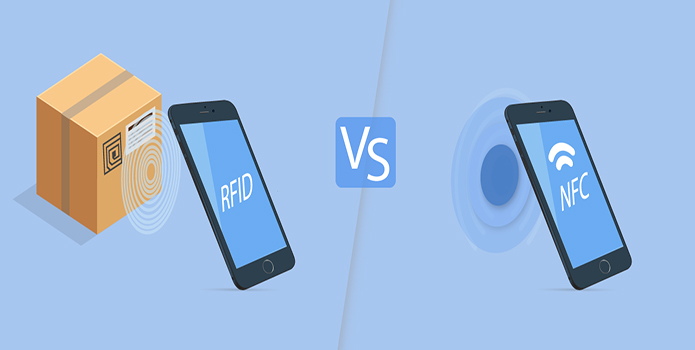The primary difference between RFID and NFC is that NFC works only with short distances (usually less than 10 cm), and it can be powered by capacitive energy transfer.
On the other hand, RFID uses the frequency of 125 kHz/13.56 MHz and requires a power source (battery or induction coil). It offers a maximum range of 100 meters.
Besides these differences, the technologies are pretty similar. This article gives an in-depth comparison between NFC and RFID.
RFID란 무엇인가요?
RFID (Radio Frequency Identification) is a wireless non-contact technology that uses electromagnetic fields to transfer data from the Tag (transponder) to the Reader (interrogator).
The two main components of an RFID system are a tag and a reader device, each having an antenna. The transmission medium is the air interface.
It works at very high frequencies (125 kHz/13.56 MHz). As such, it allows large amounts of data to be transferred quickly between two transponders or between a transponder and a reader.
What are the Applications of RFID?
RFID의 많은 용도가 있습니다. 산업 플랜트 또는 공장과 같은 다양한 부문에서 액세스를 조정하고 제어하는 데 사용할 수 있습니다. 이와 같이 이러한 태그는 산업 공정의 생산성을 향상시키고 원자재 및 완제품 사용을 모니터링하여 폐기물을 줄일 수 있습니다.
또한 항만이나 공항에 있는 상업용 트럭이나 컨테이너와 같은 자산을 관리하고 모니터링하는 데 유용합니다. 이러한 방식으로 도난이나 취급 부주의로 인한 손실을 방지할 수 있습니다.
예를 들어 회사에 창고가 여러 개 있는 경우 각 창고 입구에 RFID 리더기를 설치하기만 하면 어디를 가든지 상품을 찾을 수 있습니다.
RFID 기술은 다음과 같은 다른 많은 영역에서도 사용할 수 있습니다.
- 식별 및 액세스 제어
- 차량 추적
- 동물/애완동물 추적,
- 결제시스템(신용카드 연동) 및 휴대폰
NFC 란 무엇입니까?
NFC (Near field communication) is a wireless communication technology that allows two electronic devices closely placed (up to 4 cm) to establish communication and exchange data.
It is related to RFID but it works at lower frequencies (13.56 MHz). They allow large amounts of data to be transferred quickly between two transponders almost simultaneously.
NFC is comparable to Bluetooth, Infrared (IR), and Wireless LAN standards. Although each of these technologies has its protocol standard, they all establish communication using electromagnetic fields.
This technology requires short-range, so it is used to create wireless connections between small portable devices such as mobile phones or tablets.
What are NFC Tags?
An NFC tag contains information that different applications can access – usually through an NFC Service ID assigned by the manufacturer, depending on what service this tag will offer.
They have an NFC chip and an antenna embedded in a label or printed directly on a surface. The tag can be read from up to 20 cm (7.9 in) away by an active NFC device such as modern smartphones.
What are the Applications of NFC?
NFC에는 스마트폰 간의 파일 전송, 결제 시스템, 대중 교통 발권, 연락처 액세스 제어 카드 등 여러 응용 프로그램이 있습니다.
또한 빠른 데이터 전송을 위해 NFC 리더를 특정 위치에 고정할 수 있습니다. 예를 들어 ATM에서 카드 번호, 만료일, 보안 코드와 같은 유용한 정보를 읽을 수 있도록 판독기에 신용 카드를 두드려야 합니다.
이렇게 하면 은행 세부 정보를 저장하는 NFC 장치(ATM)에 액세스하지 않는 한 아무도 결제 중에 암호나 은행 계좌를 도용할 수 없기 때문에 온라인 구매가 안전합니다.
또 다른 NFC 태그 신청 광고에 있습니다. 많은 기업들이 그들의 메시지를 세상에 알리고 싶어하지만 모두가 텔레비전 광고를 살 돈이 충분하지는 않습니다. 이 회사는 내부에 NFC 태그가 내장된 회사 로고가 포함된 특수 항목을 만듭니다. 그래서 누군가 NFC 지원 모바일을 들고 근처를 걸으면 태그가 스캔되고 메시지가 팝업됩니다.
NFC 태그 장치에서 응용 프로그램이나 특정 작업을 시작하는 데 사용할 수도 있습니다. 휴대전화를 사용하지 말고 판독기에 대고 탭하라는 요청을 받는 공공 장소에서 이러한 행동을 본 적이 있을 것입니다.
이에 대한 한 가지 예는 NFC 리더에 모바일을 탭하여 온라인 구매를 할 수 있는 Google 월렛입니다. 이 작업은 Google 지갑을 시작하여 거래를 완료하는 데 필요한 데이터를 전송합니다.
RFID vs. NFC – What is The Difference?
These technologies work on the same principle: sending and receiving data without any physical contact. While their speeds are very close, RFID is faster for a wide read range while NFC works in a smaller area.
Both RFID and NFC do not require a direct line of sight. As such, you can read the tags from whichever angle you find convenient. This feature makes the tag more reliable and faster compared to barcodes.
However, there are a few differences between RFID and NFC, including:
- Frequency of Operation. NFC operates only at 13.56 MHz while RFID can operate within a frequency range of 134.2 kHz to over 900 MHz.
- 읽기 범위. NFC operates optimally when the reader and the tags are a maximum of 10 cm away from each other. This short read range limits NFC to data exchange, contactless payments, and proximity cards. On the other hand, RFID tags can have a read range of up to 100 meters, thus making them ideal for tracking.
- Memory. RFID tags have a larger memory capacity than NFC. The feature makes them useful where you need to store massive amounts of data. Most RFID tags are not writable so it will be hard to change the data on there without erasing everything and writing it again. However, you can get one with write/read abilities.
- Functionality. RFID deals particularly with identification while NFC deals with communication. RFID is ideal for processing large amounts of data within a short time.
Both NFC and RFID are highly reliable. However, you should define your needs before you settle for one. If you need one for identification and access control, then we recommend RFID. If you need one for communication and data exchange, then you should choose NFC.


